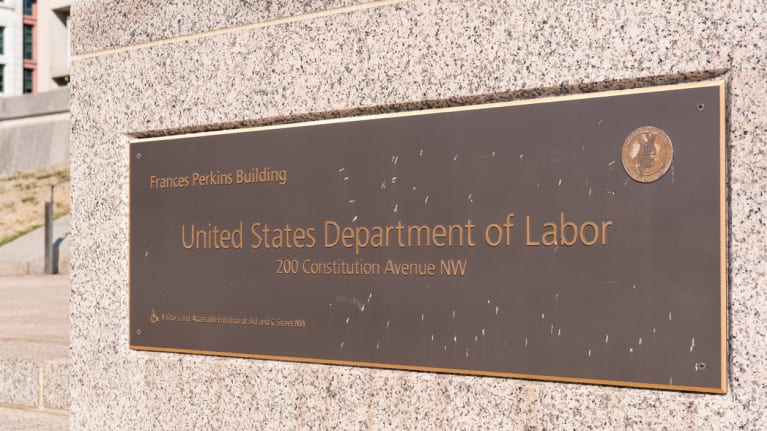

?The U.S. Department of Labor (DOL) has issued a proposed form revision calling for federal contractors that use “persuaders”—consultants or attorneys who inform employees about the possible effects of unionization—to be publicly identified. The proposal could result in fewer contractors using persuaders.
The DOL recommended adding a box to its LM-10 form, which employers that engage persuaders file, for federal contractors and subcontractors to check if engaged in persuader activity.
“The public exposure would allow for an open public discussion and debate about the prevalence of persuader activity and the extent to which specific federal agencies might be indirectly supporting such activities by doing business with employers that engage in persuader activities,” the DOL stated in its justification for the change.
“The proposed change may have a chilling effect because the rule is described as being crafted to identify ‘unethical’ employer activities, and similarly negative terms,” according to Cheryl Behymer, an attorney with Fisher Phillips in Columbia, S.C., and Todd Lyon, an attorney with Fisher Phillips in Portland, Ore., in a joint e-mail.
“The LM-10 proposal notes that it will allow employees and contracting agencies to identify employers that may be using federal funding to what the rule characterized as resisting union activity, thereby allowing contracting agencies to reject those employers on future federal projects,” they noted.
Closer Scrutiny
“Employees have a particular interest in knowing whether their employers are federal contractors because, as taxpayers themselves, those employees should know whether they are indirectly financing persuading campaigns regarding their own rights to organize and bargain collectively,” the DOL stated.
“Persuader campaigns are not themselves reimbursable under the federal contract or subcontract. Nevertheless, federal contractors receive federal dollars—often in significant amounts—for goods and services. Such funds support directly or indirectly contractors’ businesses and additional activities, which may include the decision to hire the outsider to persuade the employees.”
“One outcome of the revised LM-10 would be that employees could decline to work for federal contractors or subcontractors that file these reports,” Behymer and Lyon noted.
Executive Order 13494, issued by the Obama administration, prohibits the government from reimbursing contractors for the cost of persuader or surveillance activity.
“Coupled with this requirement, agencies are likely to take a second look at the contracts awarded to companies that have engaged in persuader or surveillance activity,” said David Pryzbylski, an attorney with Barnes & Thornburg in Indianapolis. “Most importantly, these disclosures could drive the selection of contractors for future awards and may lead to less awards to companies that have previously disclosed such activity.”
The proposed change to the form would help employees of federal contractors that use persuaders to contact Congress to ask about the amount of federal appropriations underlying the contracts. It also would help the employees work more effectively with advocacy groups and the media, the DOL noted.
Union organizers might use the persuader information in the organizing process, Pryzbylski said.
For example, a union could learn that a company spent thousands of dollars—or more—on persuading services and then inform employees in a campaign of that fact to sow distrust with the employer. “I’ve seen unions say in campaigns, for instance, that the use of persuaders shows a company is afraid of the union’s power and has something to hide,” he noted.
Pryzbylski said it’s likely the LM-10’s information about contractors that use persuaders will result in organized labor “ratcheting up the pressure on employers to abandon these practices.”
Persuader Activity Is Lawful Within Limits
The government acknowledged in its justification for the proposed change that persuader activities are lawful.
Lawful persuader activity occurs when a company hires a consultant or an attorney to inform employees about the exercise of their rights to organize or not under the National Labor Relations Act (NLRA).
There are four categories of lawful persuader activity, said Jeff Stankunas, an attorney with Isaac Wiles in Columbus, Ohio:
- Direct persuasion.
- Indirect persuasion.
- Providing persuader materials.
- Hosting persuading seminars.
“Employers may hire consultants to talk directly to employees during a union campaign to discuss their personal experiences and opinions as to why unionization may not be in the best interest of the workforce or company,” Stankunas said.
Some labor consultants are former union organizers or officials who now work for organizations that provide persuader services, Pryzbylski noted. “Depending on the campaign, some companies routinely use these types of services,” he said.
There are legal limits on what persuaders can say under the NLRA.
“TIPS,” is an acronym standing for prohibitions on:
- Threats.
- Interrogating employees about their union sympathies.
- Promising employees certain benefits in exchange for exercising rights.
- Spying on employees exercising their union rights.
Push for Unionization
“The issue of labor organizing is getting a lot of attention at the federal level, from the vocal agenda issued by the new NLRB [National Labor Relations Board] general counsel, to President Biden’s support for the PRO—Protecting [the] Right to Organize—Act, which has not passed Congress,” said Nisha Verma, an attorney with Dorsey & Whitney in Costa Mesa, Calif.
“The DOL’s proposed revisions to the LM-10 are a continuation of that trend,” she explained.
In addition to recommending the addition of a checkbox, the proposal recommends adding two lines for entry of the filer’s Unique Entity Identifier and federal contracting agency or agencies. The Unique Entity ID is the official identifier for doing business with the U.S. government as of April 4.

